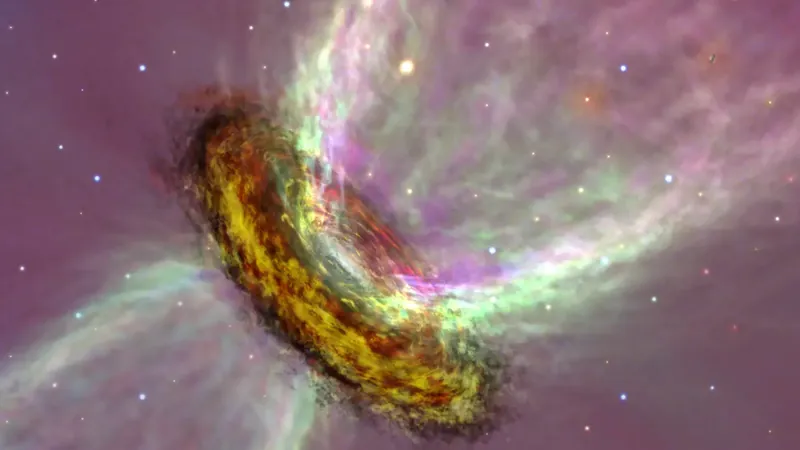
James Webb Space Telescope Unveils Secrets of Dusty 'Pancakes' Nurturing Baby Stars and Forming Planets
2024-10-07
Author: Emma
Introduction
In a groundbreaking revelation, astronomers utilizing the James Webb Space Telescope (JWST) have illuminated the chaotic "pancakes" of gas and dust encircling young stars, pivotal in their development and in the genesis of planets. These protoplanetary disks are not merely stunning celestial phenomena; they are critical to the evolutionary story of stars and their planetary systems.
Recent Observations
Recent observations have unveiled intricate details about the "winds of change" sweeping through these disks, shaping their structure and facilitating the accretion process. This knowledge touches upon a long-standing enigma in astrophysics concerning how young stars accrue necessary materials from their disks for growth.
Research Team and Findings
Led by Ilaria Pascucci at the University of Arizona, the research team scrutinized four protoplanetary disk systems, which appeared edge-on from Earth's vantage point. Their findings represent an unprecedented step forward in understanding the dynamics that mold protoplanetary disks. In essence, they provide a window into what our solar system might have looked like around 4.6 billion years ago, prior to Earth's formation.
Pascucci emphasized the significance of their findings: "Our observations strongly suggest that we have obtained the first detailed images of the winds that can remove angular momentum and solve the longstanding problem of how stars and planetary systems form." She noted that the manner in which a star collects mass profoundly affects the evolution of its surrounding disk and consequently the formation of planets.
The Birth of Stars
The birth of stars is a breathtaking process. In our observable universe, it's estimated that 3,000 stars are born every single second! These nascent celestial bodies, termed protostars, are enveloped in a dense cocoon of gas and dust. As the protostar draws material over time, this surrounding cloud compresses and flattens, setting the stage for the star to turn into a main-sequence star, one of the most stable phases in stellar evolution.
The Critical Question of Mass Accumulation
Yet, a critical question arises: How does a protostar manage to gather mass without getting stuck in an endless orbit around itself? The intriguing answer possibly lies in the loss of angular momentum. Without this loss, the swirling gas would remain perpetually suspended around the protostar.
Mechanisms of Angular Momentum Loss
While several mechanisms have been proposed, the recent hype surrounding magnetic field-driven winds appears to hold promise. These winds may effectively strip gas from the protoplanetary surface, allowing material to fall toward the protostar and feed its growth.
Challenges in Understanding Wind Mechanisms
Researcher Tracy Beck from NASA's Space Telescope Science Institute highlighted the challenge of separating the influences of various wind-generating mechanisms within protoplanetary disks. For instance, a protostar's magnetic field produces X-winds emanating from the inner disk, while powerful radiation from the star erodes the outer disk, generating slower thermal winds.
JWST's Role in Analysis
The JWST’s unmatched infrared capabilities allowed for this complex analysis, as it could discern between these different wind types with exceptional precision. The team's target was well-chosen; the edge-on orientation of the disk served as a natural shield against glare from the protostars, enabling clear observations.
Publication and 3D Representation
The groundbreaking study was detailed in the journal *Nature Astronomy*, published on October 4. The researchers produced a vivid 3D representation of the jets emerging from the disks, revealing distinct central voids that may be signatures of these winds.
Future Research Directions
Looking ahead, the research team plans to expand their investigation into additional protoplanetary disks to discern whether the observed central holes are a ubiquitous feature and to understand their implications for star feeding and planet formation.
Conclusion
Pascucci concluded, "We believe these central holes could be a common phenomenon, but it is still a puzzle with only four observed systems. Our aspiration is to analyze a larger array with JWST and ascertain if these winds undergo modifications during stellar assembly and planetary formation." As the James Webb Space Telescope continues its mission, astronomers are on the cusp of unlocking further cosmic mysteries, shaping our understanding of how stars and planets come into existence. The journey into the dark, dusty corners of our universe is just beginning—stay tuned for more celestial discoveries!









 Brasil (PT)
Brasil (PT)
 Canada (EN)
Canada (EN)
 Chile (ES)
Chile (ES)
 España (ES)
España (ES)
 France (FR)
France (FR)
 Hong Kong (EN)
Hong Kong (EN)
 Italia (IT)
Italia (IT)
 日本 (JA)
日本 (JA)
 Magyarország (HU)
Magyarország (HU)
 Norge (NO)
Norge (NO)
 Polska (PL)
Polska (PL)
 Schweiz (DE)
Schweiz (DE)
 Singapore (EN)
Singapore (EN)
 Sverige (SV)
Sverige (SV)
 Suomi (FI)
Suomi (FI)
 Türkiye (TR)
Türkiye (TR)